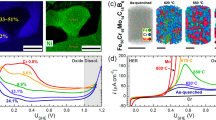The interaction of Sc2Ni7 and Zr2Ni7 compounds (with C2/m and P63/mmc crystal structures and congruent melting temperatures of 1270 and 1438°C) in the ternary Ni–Sc–Zr system was studied employing physicochemical analysis methods (metallography, X-ray diffraction, differential thermal analysis, and electron microprobe analysis). The section between the compounds was shown to be quasibinary of peritectic type, with peritectic points of 1340 ± 13°C and 14 at.% Sc. At the peritectic temperature, about 10 at.% Zr dissolves in the Sc2Ni7-based phase and about 8 at.% Sc in the Zr2Ni7-based phase. Electrochemical studies conducted through cathodic polarization of the ternary Sc2Ni7 and Zr2Ni7 alloys using a PI-50-1 potentiostat, with a three-electrode electrochemical cell consisting of a working ceramic anode, a platinum cathode, an electrolyte (a 3% NaCl aqueous solution), and a silver chloride Ag/AgCl/KCl reference electrode, did not reveal any tendency to hydrogenation in their solid solutions. The influence of preliminary cathodic reduction of the 77.8 at.% Ni–8 at.% Sc–Zr sample on its subsequent anodic dissolution was determined. The initial surface of the 77.8 at.% Ni–8 at.% Sc–Zr sample was found to be much more resistant to anodic oxidation than the surface preliminary subjected to cathodic reduction because of a significant decrease in its oxide component.





Similar content being viewed by others
References
G.G. Libowitz, H.F. Hayes, and T.R.G.Jr. Gibb, “The system zirconium–nickel and hydrogen,” J. Phys. Chem., 62, No. 1, 76–79 (1958).
Q.W. Yang and T. Zhang, “Composition dependence of structural evolution of Ni–Zr alloys during cooling,” J. Phys. Condens. Matter, 19, 086212–086221 (2007).
X.J. Liu, X.D. Hui, G.L. Chen, and T. Liu, “Local atomic structures in Zr–Ni metallic glasses,” Phys. Lett. A, 373, 2488–2493 (2009).
I. Hu, Z.F. Li, W.S. Lai, and B.X. Liu, “A proposed damage gradient model for the sequential disordering induced in Sc–Ni multilayers by ion irradiation,” J. Phys. Condens. Matter, 14, 731–737 (2002).
J. Nei, K. Young, S.O. Salley, and K.Y.S. Ng, “Effects of annealing on Zr8Ni19X2 (X = Ni, Mg, Al, Sc, V, Mn, Co, Sn, La and Hf): Structural characteristics,” J. Alloys Compd., 516, 144–152 (2012).
L. Fan, L.Q. He, H.S. Liu, H.L. Peng, and Z.P. Jin, “Measurement of phase equilibria in Zr–Ni–Sc ternary system,” Calphad, 65, 25–33 (2019).
N. Bochvar, O. Abdulov, T. Dobatkina, M. Kareva, and O. Semenova, in: G. Effenberg (ed.), Ni–Zr Binary Phase Diagram Evaluation, MSI Eureka, MSI (Materials Science International), Stuttgart (2015), Document ID: 20.11406.1.2.
E.L. Semenova, in: G. Effenberg (ed.), Ni–Sc Binary Phase Diagram Evaluation, MSI Eureka, MSI (Materials Science International), Stuttgart (2013), Document ID: 20.20121.1.3.
G. Nolze, “PowderCell: A mixture between crystal structure visualizer, simulation and refinement tool,” in: Proc. 2nd Int. School on Powder Diffraction (Kolkata, January 20–23, 2002), Kolkata (2002), pp. 146–155.
Q. Guo and O.J. Kleppa, “The standard enthalpies of formation of the compounds of early transition metals with late transition metals and with noble metals as determined by Kleppa and co-workers at the University of Chicago—A Review,“ J. Alloys Compd., 321, No. 2, 169–182 (2001).
J.H. Zhu, “Enthalpies of formation of binary Laves phases,” Intermetallics, 10, 579–595 (2002).
S. Kardellass, C. Servant, N. Selhaoui, A. Iddaoudi, M. Ait Amar, and L. Bouirden, “Thermodynamic description of the Ni–Sc system,” Calphad, 42, 59–65 (2013).
J.A. Goubel and S. Rosen, “Phase equilibria in the nickel–aluminum–scandium system at 1000°C,” J. Less-Common Met., 16, No. 4, 441–446 (1968).
H. Shen, L.A. Bendersky, K. Young, and J. Nei, “Fine structure in multi-phase Zr8Ni21–Zr7Ni10–Zr2Ni7 alloy revealed by transmission electron microscope,” Materials, 8, 4618–4630 (2015).
B.B. Damaskin and O.A. Petriy, Introduction to Electrochemical Kinetics [in Russian], Vysshaya Shkola, Moscow (1975), p. 416.
L.I. Antropov, Theoretical Electrochemistry [in Russian], Vysshaya Shkola, Moscow (1975), p. 560.
I.D. Gorna, V.M. Talash, K.O. Valuyska, O.V. Vdovychenko, P.M. Romanko, A.V. Kotko, M.D. Bega, V.S. Goltvianytsia, and S.O. Firstov, “Effect of scandium on the properties of biocompatible Ti–23Nb–2Zr–X titanium alloys,” in: Proc. Int. Conf. Titanium 2018. Production and Use in Ukraine (June 11–13, 2018, Paton El. Weld. Inst.), Svarka, Kyiv (2018), pp. 40–43.
V.A. Shvets, E.L. Semenova, V.A. Lavrenko, and V.N. Talash, “Anodic oxidation of Zr–Ni intermetallics in alkaline electrolytes after surface treatment with atomic hydrogen under cathodic polarization,” Powder Metall. Met. Ceram., 52, No. 5–6, 336–339 (2013).
Author information
Authors and Affiliations
Corresponding author
Additional information
Translated from Poroshkova Metallurgiya, Vol. 62, Nos. 3–4 (550), pp. 134–143, 2023.
Rights and permissions
Springer Nature or its licensor (e.g. a society or other partner) holds exclusive rights to this article under a publishing agreement with the author(s) or other rightsholder(s); author self-archiving of the accepted manuscript version of this article is solely governed by the terms of such publishing agreement and applicable law.
About this article
Cite this article
Semenova, O.L., Fomichov, O.S., Meleshevich, K.A. et al. Interaction in the Ni–Sc–Zr Ternary Alloys Along the 77.8 at.% Ni Section. Electrochemical Properties of the Alloys. Powder Metall Met Ceram 62, 241–249 (2023). https://doi.org/10.1007/s11106-023-00388-z
Received:
Published:
Issue Date:
DOI: https://doi.org/10.1007/s11106-023-00388-z




